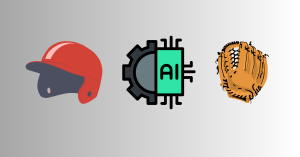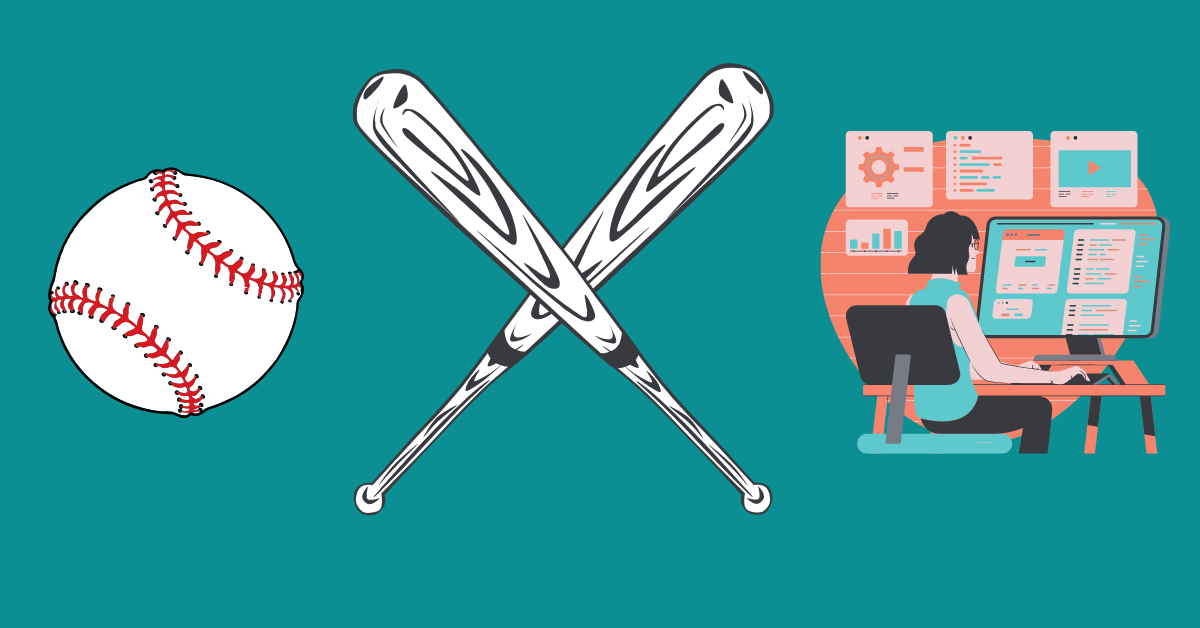How Technology is Revolutionizing America’s Pastime from the Dugout to the Stands
Baseball in the Age of AI and Analytics
Introduction
Baseball has always been a sport steeped in tradition, evoking memories of simpler times. But look closer, and you’ll see that America’s favorite pastime is undergoing a quiet revolution.
The game of baseball is being transformed by an unlikely teammate: technology. From the dugout to the outfield, from player training to fan experiences, cutting-edge innovations are reshaping every aspect of the sport we love.
Gone are the days when managers relied solely on gut instinct and players honed their skills through endless repetition. Today’s baseball is a high-tech affair, where data analytics, artificial intelligence, and virtual reality play as crucial a role as the bats and gloves themselves.
In this blog post, we’ll take you on a journey through the tech-driven evolution of baseball. We’ll explore how instant replay is changing the way games are officiated, how advanced analytics are influencing strategy, and how state-of-the-art training methods are pushing players to new heights of performance.
We’ll also delve into how technology is revolutionizing the fan experience, both at the stadium and at home. From mobile apps that let you order food to your seat, to immersive broadcast technologies that make you feel like you’re right in the action, baseball is embracing the digital age like never before.
So grab your tablet (scorecard is so last season), and join us as we explore the fascinating intersection of America’s pastime and cutting-edge technology. It’s a brave new world of baseball, where tradition meets innovation, and the future of the game is being written in lines of code as much as chalk lines on the field.
Video Replay: Getting the Call Right
Remember the days when a bad call could make or break a game, leaving fans fuming and players arguing fruitlessly with umpires? Those days are (mostly) behind us, thanks to MLB’s sophisticated instant replay system.
The Evolution of Instant Replay
Baseball’s journey into the world of video review began in 2008 with a modest start: only disputed home runs could be reviewed. But in 2014, MLB took a giant leap forward, expanding their replay system to cover a wide range of plays. This move ushered in a new era of accuracy and fairness in America’s pastime.
How It Works: The Challenge System
Today’s replay system puts some of the power in the hands of the managers. Here’s how it works:
- Each manager gets one challenge per game.
- If their challenge is successful and the call is overturned, they retain the right to challenge one more play.
- From the 8th inning on, umpires can initiate a review if they’re uncertain about a call.
But what exactly can be challenged? The list includes:
- Home runs and ground rule doubles
- Force and tag plays
- Fair/foul balls in the outfield
- Fan interference
- Baserunning infractions
- And more!
The Impact: Game-Changing Moments
The numbers don’t lie: more than half of all challenged calls are overturned. That’s a lot of potentially game-altering moments being corrected. While purists might argue that human error is part of the game, many fans and players love the increased accuracy that replay brings to crucial moments.
Looking Ahead: Balls and Strikes
As great as instant relplay has been, balls and strikes called behing home plate don’t fall under the challenge protocols, but will that soon be changing?? The plot thickens!
There as talk of implementing an Automated Ball-Strike (ABS) system during spring training in 2025. This system would allow pitchers, catchers, and hitters to challenge balls and strikes calls with the help of AI. The ABS system would use Hawk-Eye camera technology and AI algorithms to determine whether a pitch falls inside the strike zone. Oh boy! Imagine the strategy involved in deciding when to use your challenge on a borderline pitch!
While the human element of umpiring remains an important part of baseball, the replay system has undoubtedly changed the game for the better. It’s a prime example of how technology can enhance rather than replace traditional aspects of the sport, ensuring that the outcome of games are determined by the players on the field, not by missed calls.
As we continue to embrace technology in baseball, the balance between tradition and innovation remains a hot topic. But one thing’s for sure: in the tech-driven world of modern baseball, the phrase “upon further review” has become music to the ears of players and fans alike.
Statcast and Advanced Analytics: The Numbers Game
If you’ve watched a baseball game recently, you’ve probably heard commentators throwing around terms like “exit velocity” and “launch angle.” Welcome to the world of Statcast and advanced analytics, where every pitch, hit, and catch is quantified and analyzed in mind-boggling detail.
What is Statcast?
Introduced in 2015, Statcast is a state-of-the-art tracking technology that uses high-resolution Hawk-eye cameras and radar equipment installed in every MLB stadium. This system captures and analyzes data on virtually every aspect of the game, providing insights that were unimaginable just a few years ago.
The Key Metrics: Baseball’s New Language
Statcast has introduced a whole new vocabulary to baseball. Here are some of the key metrics it tracks:
- Exit Velocity: How fast the ball comes off the bat. A higher exit velocity generally means a harder hit ball, which is more likely to result in a hit.
- Launch Angle: The vertical angle at which the ball leaves the bat. Launch angle can help tell us what type of player a hitter or pitcher is. Is a hitter a fly-ball hitter (high launch angle) or a ground-ball hitter (low launch angle)? Is a pitcher a fly-ball pitcher (high launch angle allowed) or ground-ball pitcher (low launch angle allowed)?
- Spin Rate: How much a pitch is spinning, measured in rotations per minute (rpm). Higher spin rates can make fastballs appear to “rise” and breaking balls move sharply.
- Sprint Speed: How fast a player runs, measured in feet per second. This applies to baserunning and fielding.
- Catch Probability: The likelihood of a fielder making a catch based on the distance they need to cover and the time they have to do it.
How Teams are Using the Data
This wealth of information is changing how teams approach every aspect of the game:
- Player Evaluation: Teams use exit velocity and launch angle data to identify potential power hitters, even before that power shows up in traditional statistics.
- Pitching Strategy: Pitchers and coaches analyze spin rate data to perfect pitch selection and design.
- Defensive Positioning: Those extreme infield shifts you see? They’re often based on detailed spray charts derived from Statcast data.
- Player Development: Minor league systems use similar technology to track the progress of prospects and identify areas for improvement.
- In-Game Decisions: Managers leverage this data to make crucial decisions during games, from pitching changes to defensive substitutions.
The Impact on the Game
The influence of Statcast and advanced analytics on baseball cannot be overstated. We’re seeing:
- The “launch angle revolution” in hitting, with more players adjusting their swings to optimize for power.
- Pitchers obsessing over spin rates and developing new pitches based on the data.
- Defensive strategies evolving, with positioning becoming more precise and dynamic.
- A new appreciation for skills that were previously undervalued, like outfield route efficiency.
The Human Element
While the numbers provide invaluable insights, baseball remains a human game. The challenge for teams is to balance the wealth of data with the intangible aspects of player performance and team chemistry. The most successful organizations are those that can blend advanced analytics with traditional scouting and development methods.
As we continue to push the boundaries of what can be measured and analyzed in baseball, one thing is clear: the game we see on the field in 2024 is more informed by data than ever before. Whether you’re a stats geek or a traditionalist, there’s no denying that Statcast and advanced analytics have added a fascinating new dimension to America’s pastime.
High-Tech Training: The New Way to Practice
Gone are the days when batting practice and bullpen sessions were the height of baseball training. In 2024, the way players hone their skills looks more like a sci-fi movie than traditional spring training. Let’s dive into the high-tech world of modern baseball training.
Wearable Technology: The Invisible Coach
Wearable devices have become an indispensable part of player development, providing insights that were once impossible to quantify. Here’s how they’re changing the game:
- Smart Arm Sleeves: Pitchers now wear sleeves with built-in sensors that track arm speed, stress, and fatigue in real-time. This data helps prevent injuries and optimize performance.
- Smart Bats: Embedded sensors collect data on swing speed, bat angle, and point of contact, helping hitters perfect their technique.
It’s important to note that while these gadgets are invaluable for training, they’re not allowed during actual games. The field is still sacred ground where players rely on their honed skills rather than real-time data.
Virtual Reality: Practice Makes Perfect
Virtual Reality (VR) is revolutionizing how players prepare for game situations:
- Batting Practice 2.0: Batters can face simulated pitches from star pitchers in the league, getting valuable “at-bats” without the physical wear and tear.
- Catching Simulators: Catchers use VR to practice calling games and framing pitches against a variety of virtual batters.
- Fielding Scenarios: Infielders and outfielders can take hundreds of reps on difficult plays, improving their reaction times and decision-making.
These VR systems allow for focused, repetitive practice that would be impractical or impossible in real-life settings.
Biomechanics: The Science of the Perfect Swing
Teams are increasingly turning to biomechanics to unlock peak performance:
- 3D Motion Capture: High-speed cameras and motion sensors create detailed 3D models of a player’s movements, allowing for minute analysis of pitching mechanics or swing patterns.
- Force Plates: These devices measure how players generate power from the ground up, helping to optimize everything from a pitcher’s drive off the mound to a batter’s weight transfer during a swing.
- High-Speed Cameras: Capable of capturing thousands of frames per second, these cameras break down movements to the millisecond, revealing inefficiencies invisible to the naked eye.
This technology helps players not only improve their performance but also reduce their risk of injury by identifying and correcting problematic movements early.
The Impact on Player Development
All of this technology is fundamentally changing how players improve their skills:
- Personalized Training: Programs are now tailored to individual players based on their unique data profiles.
- Rapid Skill Acquisition: Players can identify and correct flaws in their technique much faster than before.
- Injury Prevention: By analyzing movement patterns and stress points, teams can address potential injury risks before they become problems.
Balancing High-Tech and Traditional Methods
While these technologies offer incredible benefits, successful teams know the importance of balancing high-tech tools with traditional coaching methods. The human element – the experience of seasoned coaches, the mentorship of veterans, the intangibles of team chemistry – remains crucial.
The challenge lies in integrating these new technologies without overwhelming players with data. The goal is to use tech to enhance natural talents, not to create robots on the field.
The Future of Player Development
As technology continues to advance, we can only imagine what’s next for baseball training. Will we see AI-powered coaching assistants? Augmented reality training fields? The possibilities are as exciting as they are endless.
One thing is certain: the players stepping onto the field in 2024 are more prepared, more finely tuned, and more knowledgeable about their own abilities than ever before. And that’s translating into a level of play that’s pushing the boundaries of what we thought was possible in America’s pastime.
Fan Experience 2.0: The Modern Ballpark
From the moment you decide to attend a game to long after the final out, technology is enhancing every aspect of the fan experience. Let’s take a tour of the modern ballpark and see how tech is changing the game for fans.

Mobile Apps: Your Digital Ticket to the Game
Remember fumbling with paper tickets or printouts? Those days are gone. The MLB Ballpark app has become an essential part of the modern fan’s toolkit:
- Digital Tickets: Your smartphone is now your ticket to the game. No more lost or forgotten tickets – it’s all in your pocket.
- Seat Upgrades: Spot a better seat? Many stadiums now allow in-app upgrades, letting you move to premium locations if they’re available.
- Concession Ordering: At some parks, you can order food and drinks right from your seat and have them delivered or ready for pick-up, minimizing time away from the action.
- Interactive Stadium Maps: Never get lost looking for that craft beer stand again. Interactive maps guide you to amenities throughout the park.
Jumbotrons on Steroids: The Visual Experience

Today’s stadium video boards are so crisp and detailed, you might forget you’re not watching on your 4K TV at home:
- Instant Replays: See that close play from multiple angles in crystal-clear detail.
- Live Stats: Watch as player stats update in real-time after each play.
- Fan Engagement: Between-inning entertainment has gone high-tech with interactive games and social media integration.
Connectivity: Always Online
Modern ballparks are equipped with high-speed Wi-Fi and improved cellular coverage, ensuring you’re always connected:
- Share your experience on social media in real-time.
- Check stats or follow other games without missing a pitch.
- Stream exclusive in-stadium content for a more immersive experience.

Bringing the Ballpark Home: The At-Home Experience
Can’t make it to the game? The at-home viewing experience has been revolutionized too:
- 4K Broadcasts: Ultra-high-definition cameras capture every bead of sweat and blade of grass.
- Statcast Integration: Broadcasts now routinely feature advanced metrics, giving viewers insights previously available only to teams.
- Multi-Angle Replays: Choose your preferred camera angle or watch a play from multiple perspectives simultaneously.
Balancing Tech and Tradition
In 2024, whether you’re at the stadium or watching from home, technology is bringing you closer to the game than ever before. It’s creating new ways to engage with America’s pastime, ensuring that baseball remains relevant and exciting for generations to come.
The Strategic Revolution: Data-Driven Decisions
While the fundamentals of baseball remain the same, the way the game is managed and played has undergone a radical transformation thanks to technology. From the front office to the dugout, data and analytics are reshaping strategy and decision-making at every level. Let’s explore how technology is changing the chess match that is baseball.
Lineup Construction: It’s All in the Numbers
Gone are the days when managers simply put their best hitter in the cleanup spot. Today’s lineup construction is a science:
- Optimization Algorithms: Teams use complex mathematical models to determine the most effective batting order based on countless variables.
- Matchup Analysis: Lineups often change based on the opposing pitcher, with decisions informed by detailed historical data and predictive models.
- Platoon Advantages: Advanced analytics have led to more specialized platoon situations, maximizing favorable batter-pitcher matchups.
In-Game Strategy: There’s an App for That
Managers are no longer relying solely on gut instinct. They’re armed with tablets and real-time data in the dugout:
- Pitch Selection: Catchers and pitchers consult devices that suggest optimal pitch types and locations based on the batter’s tendencies and current situation.
- Defensive Positioning: Those extreme shifts you see? They’re based on spray charts and probability models updated in real-time.
- Bullpen Management: Decisions about when to pull a starter or which reliever to use are now informed by fatigue metrics, matchup data, and even weather models.
Scouting and Player Acquisition: Moneyball 2.0
The “Moneyball” revolution was just the beginning. Today’s scouting departments look more like tech startups:
- AI-Powered Prospect Identification: Machine learning algorithms help identify promising players in the minors and amateur ranks, sometimes spotting talent that traditional scouting might miss.
- Biomechanical Analysis: Teams use motion capture technology to assess a player’s mechanics and project their future performance and injury risk.
- Global Scouting: Advanced video analysis and data sharing have revolutionized international scouting, allowing teams to evaluate talent worldwide more effectively.

The Rise of Analytics Departments
Every MLB team now has a dedicated analytics department, staffed with data scientists, statisticians, and programmers. These departments:
- Develop proprietary algorithms and metrics to gain a competitive edge.
- Create predictive models for player performance and team outcomes.
- Work closely with coaches and players to translate data into actionable insights.
Player Development: Data-Driven Improvement
The integration of technology into player development has accelerated skill acquisition and refinement:
- Hitters use launch angle and exit velocity data to optimize their swings.
- Pitchers leverage spin rate analysis to develop and refine pitches.
- Fielders use probability models to improve their positioning and route efficiency.
The Human Element: Still in Play
Despite the influx of technology and data, baseball remains a human game. Successful teams find a balance:
- Data Translation: The best managers and coaches excel at translating complex data into simple, actionable advice for players.
- Psychology Matters: Understanding player psychology and maintaining team chemistry is still crucial, something no algorithm can fully capture.
- Intuition and Experience: There’s still room for the human touch in decision-making, especially in high-pressure situations where intangibles come into play.
Looking Ahead: The Future of Baseball Strategy
As technology continues to advance, we can expect:
- More sophisticated AI models for in-game decision making.
- Increased use of real-time data and wearable tech during games (if rules allow).
- Further integration of virtual and augmented reality in strategy and player development.
The strategic aspect of baseball has always been one of its most intriguing elements. In 2024, that chess match is being played with more information and technological support than ever before. While this has led to a more analytical approach to the game, it has also opened up new avenues for innovation and competition, ensuring that the battle of wits remains a central and evolving part of America’s pastime.
Baseball in the Digital Age
As we’ve explored throughout this post, technology have fundamentally transformed America’s pastime. From the way games are officiated to how players train, from the fan experience to the strategic decisions made in dugouts and front offices, baseball in 2024 is a far cry from the game of just a decade ago.
The Pros: A Game Enhanced
The integration of technology into baseball has brought numerous benefits:
- Increased Accuracy: Video replay has significantly reduced game-changing incorrect calls.
- Player Performance: Advanced analytics and high-tech training methods are helping players reach new heights of performance.
- Fan Engagement: Technology has made the game more accessible and interactive for fans, both at the ballpark and at home.
- Strategic Depth: Data-driven decision making has added layers of complexity to the game’s strategy.
- Player Health: Biometric data and biomechanical analysis are helping prevent injuries and extend careers.

The Challenges: Preserving the Soul of the Game
However, this technological revolution hasn’t come without its challenges:
- Information Overload: There’s a risk of overwhelming players, coaches, and fans with too much data.
- Loss of Tradition: Some fear that the human element and traditional aspects of the game are being eroded.
- Competitive Balance: There’s a concern that teams with more resources to invest in technology might gain an unfair advantage.
Looking Ahead: The Future of Baseball
As we look to the future, it’s clear that the integration of technology into baseball will continue. We might see:
- Increased use of AI in strategic decision-making
- More immersive and interactive fan experiences through VR and AR
- Further advancements in injury prevention and performance optimization
- Potential rule changes to adapt to new technologies

Final Thoughts
Baseball, a sport that has always thrived on skill, strategy, and tradition, is now entering a new era with technological advancements. These changes are not a threat to the game’s essence, but rather a promising chapter that enhances the game in new and exciting ways.
Amidst the changing tools and methods, the heart of the game remains—the timeless duel between pitcher and batter, the unmistakable crack of the bat, and the enduring roar of the crowd.
As someone who has been around the game for over 50 years, I love many of the changes that have been implemented, including instant replay. It has improved the game, and I like the chance for pitchers, catchers, and batters to challenge balls and strikes. And yes, AI and analytics have enhanced baseball, no question about it. These technologies have brought new insights and strategies to the game and have undoubtedly improved player performance and fan experience.
But we need to find a balance between AI and the tradition of baseball. The game on the field is played by humans, players, managers, and umpires who are all prone to making mistakes. We have to allow for the human factor.
My concern is that we’re heading down a road where managers are on their computers in the dugout trying to determine who to pitch in the 9th inning, not his “gut feeling.” How would the Hall of Fame managers of yesteryear do in today’s world of analytics and AI, or how about the Babe?? As the years go by, the technology will only improve, making the balancing act even harder.
The game is changing, but its heart remains the same. The enduring appeal of baseball, with its timeless essence and thrilling moments, will always be there, ready to captivate us. Play ball!





